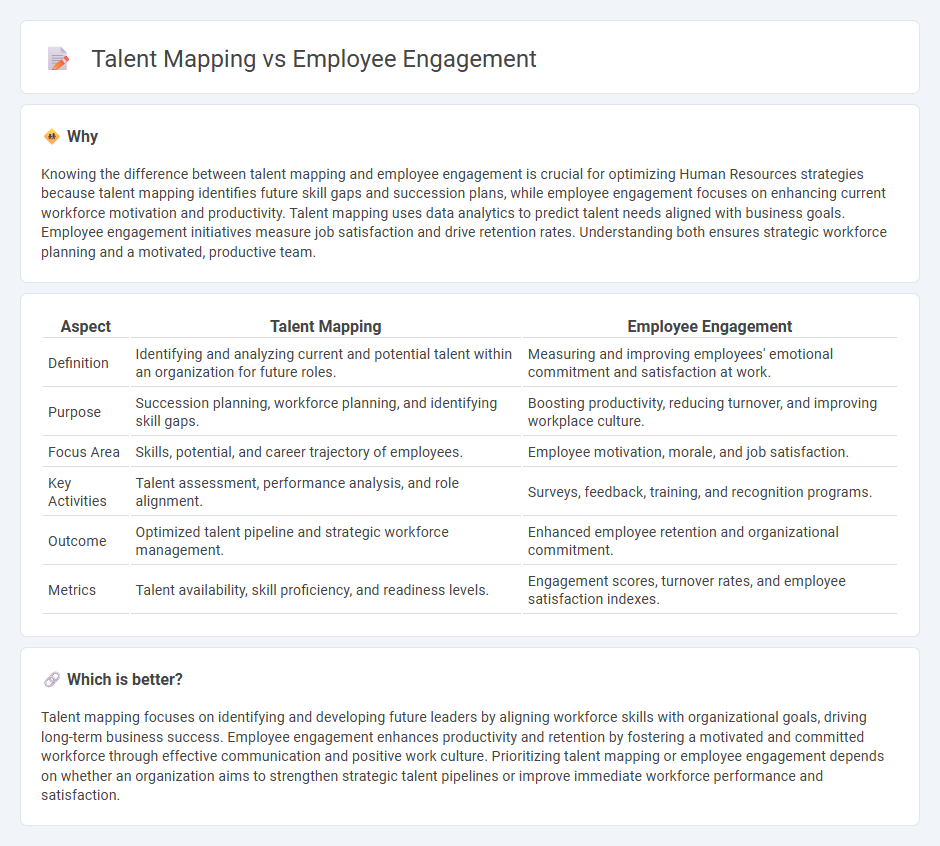
Talent mapping identifies and analyzes the skills and potential of employees to align workforce capabilities with organizational goals. Employee engagement measures the emotional commitment and motivation of employees, driving productivity and retention. Explore how balancing talent mapping and employee engagement can optimize your HR strategy.
Why it is important
Knowing the difference between talent mapping and employee engagement is crucial for optimizing Human Resources strategies because talent mapping identifies future skill gaps and succession plans, while employee engagement focuses on enhancing current workforce motivation and productivity. Talent mapping uses data analytics to predict talent needs aligned with business goals. Employee engagement initiatives measure job satisfaction and drive retention rates. Understanding both ensures strategic workforce planning and a motivated, productive team.
Comparison Table
| Aspect | Talent Mapping | Employee Engagement |
|---|---|---|
| Definition | Identifying and analyzing current and potential talent within an organization for future roles. | Measuring and improving employees' emotional commitment and satisfaction at work. |
| Purpose | Succession planning, workforce planning, and identifying skill gaps. | Boosting productivity, reducing turnover, and improving workplace culture. |
| Focus Area | Skills, potential, and career trajectory of employees. | Employee motivation, morale, and job satisfaction. |
| Key Activities | Talent assessment, performance analysis, and role alignment. | Surveys, feedback, training, and recognition programs. |
| Outcome | Optimized talent pipeline and strategic workforce management. | Enhanced employee retention and organizational commitment. |
| Metrics | Talent availability, skill proficiency, and readiness levels. | Engagement scores, turnover rates, and employee satisfaction indexes. |
Which is better?
Talent mapping focuses on identifying and developing future leaders by aligning workforce skills with organizational goals, driving long-term business success. Employee engagement enhances productivity and retention by fostering a motivated and committed workforce through effective communication and positive work culture. Prioritizing talent mapping or employee engagement depends on whether an organization aims to strengthen strategic talent pipelines or improve immediate workforce performance and satisfaction.
Connection
Talent mapping enhances employee engagement by identifying skill gaps and aligning individual strengths with organizational goals, fostering a sense of purpose and growth. Engaged employees contribute to a more accurate and dynamic talent map through continuous feedback and performance insights. This synergy enables Human Resources to implement targeted development programs and retention strategies effectively.
Key Terms
**Employee engagement:**
Employee engagement measures the emotional commitment and motivation employees have towards their organization, directly impacting productivity, retention, and workplace morale. High levels of engagement correlate with increased job satisfaction, reduced turnover rates, and enhanced overall performance. Explore strategies to boost employee engagement and transform your organizational culture.
Job satisfaction
Employee engagement directly influences job satisfaction by fostering motivation, commitment, and a positive workplace environment. Talent mapping strategically aligns employees' skills and career goals with organizational needs to enhance job fulfillment and retention. Explore how integrating employee engagement with talent mapping can boost job satisfaction and drive business success.
Motivation
Employee engagement drives motivation by fostering a sense of belonging and commitment through meaningful work and recognition, directly impacting productivity and retention rates. Talent mapping identifies high-potential employees and aligns their career paths with organizational goals, ensuring motivation remains targeted and sustainable. Discover how combining these strategies can elevate workforce performance and inspire long-term success.
Source and External Links
Why Employee Engagement Is Key to Company Success - Employee engagement is crucial for long-term retention, higher performance, and organizational success, improving productivity by 18% and profitability by 23%.
How to Improve Employee Engagement in the Workplace - Engaged employees drive business success by increasing productivity, reducing absenteeism, and enhancing profitability, with benefits seen across industries.
What Is Employee Engagement? (And How to Boost It) - Employee engagement is a key indicator of a healthy workplace, where employees feel valued and involved, leading to higher productivity, retention, and customer satisfaction.
 dowidth.com
dowidth.com